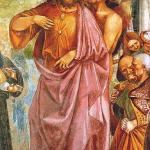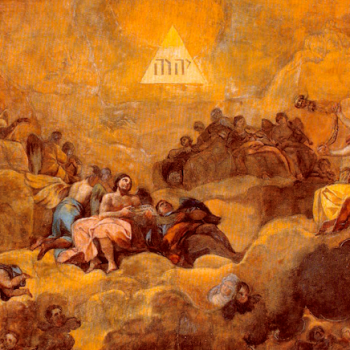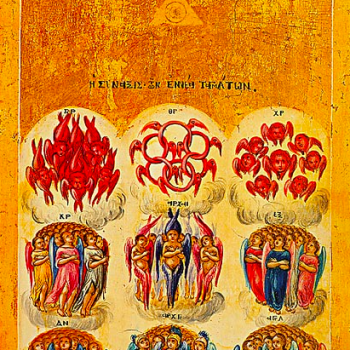Lent and the Transfiguration
As the first Sunday of Lent is devoted to the temptation in the wilderness, so the second traditionally includes an account of the Transfiguration—Matthew in Year A, Mark in Year B (e.g. 2024), and Luke in Year C. Other than Jesus forbidding the “inner circle” to discuss what had happened until after the Resurrection, the connection between Lent and the Transfiguration may seem less than obvious. Let’s situate the event in its wider context.
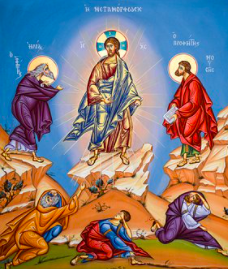
In the timeline of the text, all of this takes place one week after the whole “thou art Peter” bit. (Matthew and Mark both say “after six days,” while Luke makes it “about an eight-day” (possibly a reference to a nundinum, which was more or less the Roman equivalent of a week but had nine days instead of seven). Matthew’s account of this episode is the most complete; especially given the tradition that Mark is more or less St. Peter’s memoirs, it’s fascinating to see what Mark does and doesn’t include in his Gospel. In the selection below, the black text is Mark, while the green text is added from Matthew (everything else is word-for-word identical or very nearly). In the name of saving time and complexity, I won’t say much about the text, but I present it as the immediate background for the Gospel passage from the 25th.
Mark 8.27-38/Matthew 16.13-28
And Jesus went out, and his disciples, into the towns of Caesarea Philippi: and by the way he asked his disciples, saying unto them, “Whom do men say that I the Son of man am?” And they answered, “John the Baptist; but some say, Elias; and others, Jeremias, or one of the prophets.”
And he saith unto them, “But whom say ye that I am?” And Peter answereth and saith unto him, “Thou art the Christ, the Son of the living God.” And Jesus answered and said unto him, “Blessed art thou, Simon Barjona: for flesh and blood hath not revealed it unto thee, but my Father which is in heaven. And I say also unto thee, That thou art Peter, and upon this rock I will build my church; and the gates of hell shall not prevail against it. And I will give unto thee the keys of the kingdom of heaven: and whatsoever thou shalt bind on earth shall be bound in heaven: and whatsoever thou shalt loose on earth shall be loosed in heaven.” And he charged them that they should tell no man of him.
And he began to teach them, that the Son of man must suffer many things, and be rejected of the elders, and of the chief priests, and scribes, and be killed, and after three days rise again. And he spake that saying openly. And Peter took him, and began to rebuke him, saying, “Be it far from thee, Lord: this shall not be unto thee.” But when he had turned about and looked on his disciples, he rebuked Peter, saying, “Get thee behind me, Satan: for thou savourest not the things that be of God, but the things that be of men.”
And when he had called the people unto him with his disciples also, he said unto them, “Whosoever will come after me, let him deny himself, and take up his cross, and follow me. For whosoever will save his life shall lose it; but whosoever shall lose his life for my sake and the gospel’s, the same shall save it. For what shall it profit a man, if he shall gain the whole world, and lose his own soul? Or what shall a man give in exchange for his soul? For the Son of man shall come in the glory of his Father with his angels; and then he shall reward every man according to his works. Whosoever therefore shall be ashamed of me and of my words in this adulterous and sinful generation; of him also shall the Son of man be ashamed, when he cometh in the glory of his Father with the holy angels. Verily I say unto you, There be some standing here, which shall not taste of death, till they see the Son of man coming in his kingdom.”
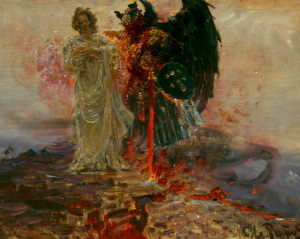
Get Thee Behind Me, Satan by Ilya Repin, 1895
So, Peter—dear, sweet, foolish Peter, the dumbass woobie of the Apostles—has put his foot in it again, and has done so immediately after a magnificent display of faith. Admittedly the “it” he put his foot in at least wasn’t the Sea of Galilee this time, though I doubt that made him feel much better about it. It’s the harshest rebuke he ever earns from Jesus, save perhaps the simple, silent look of Luke 22.61. Insofar as the other disciples looked to him as their leader, they may have felt a bit chastised themselves (and it’s almost certain they weren’t exactly keen on the whole Whosoever will come after me, let him take up his cross and follow me bit). All told, the mood among the Twelve may have been at a low ebb.
Cæsarea Philippi lies north of the Sea of Galilee, while the hill known as Mount Tabor sits to the Sea’s southwest; it’s about fifty miles between them. A week is plenty of time to travel that far on foot, so presumably that’s what they did, either lodging with friendly people in villages on the way south or just roughing it. It’s at this point that the weirdness resumes …
Mark 9.2-10, RSV-CE
And after six days Jesus tooka with him Peter and Jamesb and John, and led them up a high mountain apart by themselves; and he was transfigured before them, and his garments became glistening, intensely white, as no fuller on earthc could bleach them. And there appeared to them Elijah with Moses; and they were talking to Jesus. And Peter said to Jesus, “Master,d it is welle that we are here; let us make three booths,f one for you and one for Moses and one for Elijah.” For he did not know what to say, for they were exceedingly afraid. And a cloud overshadowed them, and a voiceg came out of the cloud, “This is my beloved Sonh; listen to him.” And suddenly looking around they no longer saw any onei with them but Jesus only. And as they were coming down the mountain, he charged them to tell no one what they had seen, until the Son of man should have risen from the dead. So they kept the matter to themselves,j questioning what the rising from the dead meant.k

Mount Tabor, the site of the Transfiguration,
photographed in 2017 by Wikimedia user Noamdahary (source).
Mark 9.2-10, my translation
And after six days, Jesus catchesa Rocky and Jacobb and John, and brings them up a high mountain, all on their own. And he is transformed in front of them, and his clothes become shining, very white, so much—no fuller on earthc could whiten them like that. And Elijah is seen, Moses with them, and they are talking together to Jesus. And Rocky replies, he says to Jesus: “Rabbi,d it is a fine thinge for us to be here, and let us make three tents,f one for you and one for Moses and one for Elijah.” For he did not know what to reply, for they had become terrified. And a cloud came, overshadowing them, and a soundg came out of the cloud: “This is my Son, my belovedh; listen to him.” And suddenly, looking around, they saw no one no morei but Jesus alone with themselves. And walking down with them from the mountain, he commanded them that they were to narrate the things they saw to no one, not until whenever the Son of Man rose from the dead. And they laid hold of the word,j discussing among themselves what this “rising from the dead” is.k
Textual Notes
a. took/catches: The word choice here isn’t that remarkable, but I wanted to take a moment to highlight something that’s common in the New Testament, but rare in translations of the New Testament (English ones, anyway). That something is what linguists call the historical present tense. Formally, this is considered bad grammar by most English speakers, but I guarantee you’ve heard it and very likely used it yourself. Lots of people recount anecdotes this way; a speaker who says So there I was in front of everyone, and I couldn’t think of anything to say means exactly the same thing as one who phrases it So there I am in front of everyone, and I can’t think of anything to say, and they’ll be understood equally easily. The difference lies primarily in tone: the historical present conveys a vividness of action that simple past tense verbs usually lack. The books of Mark and Revelation both make conspicuous use of the historical present.
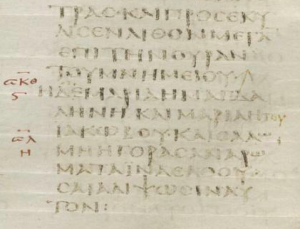
b. Peter and James/Rocky and Jacob: A lot of people know already that the nickname of Simon Peter, or Petros [Πέτρος], comes from the word petra [πέτρα] “stone, rock,” making Rocky a surprisingly exact equivalent. It’s less well-known, but equally true (and something we’ve touched on before in these notes) that James is actually a Latinized adaptation of Iakōbos [Ἰάκωβος], itself the Greek form of Ya’aqov or Yaȝaqhowv [יַעֲקוֹב], the name of the patriarch who was the technically-younger son of Isaac. The Aramaic forms of the names James, John, and Simon were fairly common at the time, so it isn’t unusual that Jesus had two disciples named James and two disciples named Simon. It is, however, quietly entertaining that, on his way to this mountaintop experience, Jesus brings with him:
- a pair of brothers
- whom he personally nicknamed the “Sons of Thunder” (and who are soon to be enveloped by a cloud),
- one of whom is named Jacob, the name of “the children of Israel,” while
- the other shares the name of St. John the Baptizer (a name which means “YHWH is merciful”—cf. Exodus 33.11-34.8); and
- thirdly, a disciple
- whom Jesus said (just a week ago) had a mystery revealed to him directly by God the Father, and
- whose non-nick name was Simon, or Shim’ȝown [ שִׁמְעוֹן ], which means “listening, hearkening,” from the same root as shema in Shema Yisrael.
c. on earth: “On earth” is a surprisingly literal rendering of the Greek here, epi tēs gēs [ἐπὶ τῆς γῆς]. I note it here only to say that gē [γῆ], “earth,” primarily meant the substance, not the planet, and it’s possible that “in the land” would be a more exact idiomatic equivalent (not that the two idioms are all that different from each other in practice anyway).
d. Master/Rabbi: The RSV here translates what I have left in Aramaic, the title “rabbi.” This does literally mean “my teacher” or “my master,” so there’s nothing incorrect about this. However, a text that is primarily in one language yet peppered with words and phrases from another produces a distinctive effect on its readers, one different from a monoglot text. I accordingly dislike this “leveling” tendency on the part of many translators; and it affects the Gospel of Mark especially, because Mark has a striking abundance of preserved Aramaic, even more so than the other Gospels or Acts. (A great stylistic counter-example, albeit not a New Testament scholar, is J. R. R. Tolkien, whose commitment to linguistic consistency in The Lord of the Rings extended even to the specific regional dialect or dead language he would draw character names from, in order to lend his narratives verisimilitude.)

A set of tzitzyot or prayer tassels (cf. Numbers 15.37-41
and Deuteronomy 22.12). These would presumably
have been among the garments Jesus was wearing
which became so brilliant that “no fuller on earth could
whiten them like that.”
e. well/a fine thing: These are alternate renderings of the adjective kalos [καλός], which originally meant “beautiful,” but over time got sort of rounded down to “good”; fine or fair have something of the right ambiguity in English to play the same role.
f. booths/tents: I’m scratching my head a little over the RSV’s choice of wording here. Their translation makes skēnē [σκηνή] mean “booth,” which … fine I guess, but it’s way more natural to translate it “tent,” to the point that it seems like they’re going out of their way not to here? The only explanation that came to my mind was that this might represent some kind of linking of the vision at the Transfiguration with the festival of Sukkot (Sukkowth [סֻכּוֹת]) or the Feast of Tabernacles: the outdoor dwellings constructed for this are more booth-like than tent-like, at least nowadays, but (a) I’m not sure if that was true at the time, and (b) connecting Transfiguration with Sukkot seems kind of arbitrary in any case. Jesus’ visit to Jerusalem in John 7-8 is a Sukkot pilgrimage—if I recall correctly, John alludes to all the major festivals imposed by the Torah, and even to at least one it doesn’t impose, Chanukkah—but I don’t know of any textual or traditional reason to assume that the Transfiguration took place around Sukkot, which generally falls some time in October on the Gregorian calendar. (The themes of Sukkot, which commemorate the deliverance from Egypt and the period the Israelites spent dwelling in tents before and after receiving the Torah at Sinai, match up well enough—but “tent” or “tabernacle” work equally well with these themes in English, whereas “booth” really only connects to this meaning via its use in describing Sukkot, so … ?)
g. a voice came out of the cloud/a sound came out of the cloud: The Greek phōnē [φωνή] can mean either. I opted for “sound” as being slightly broader, without excluding sounds of human origin.
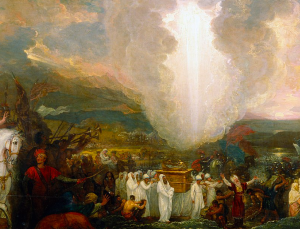
The Children of Israel Crossing the Jordan, by Benjamin West (1800)
Though not a translation difference, the “cloud” here is also worthy of note. Readers will doubtless recall that the Israelites, during and after their escape from Egypt, were guided by “a pillar of cloud by day, and a pillar of fire by night.” (This is taken by most Christian and many Jewish commentators to be a single entity, one that changed “modes” from day to night, or had two “halves,” or was simply bright compared to night-time while providing shade relative to sunlight; in some interpretations, the fire was held to be within the cloud.) Though the word does not appear in the Hebrew Bible, commentary at least as early as the Mishnah describes the presence of God in terms of the Shekinah (or sh’khiynah [שְׁכִינָה]), and archæological evidence does show that pre-Exilic Israelites venerated “YHWH and his Shekinah.”* The Shekinah was, by the time of the Mishnah, identified with the cloud of glory that protectively concealed human eyes from beholding God face to face; its descent here is, accordingly, an omen of terrible and unparalleled magnificence.
h. my beloved Son/my Son, my beloved: It so happens that in the original, this phase (ho hüios mou ho agapētos [ὁ υἱός μου ὁ ἀγαπητός]) illustrates a point of Greek grammar than—while minor and technical most of the time—is very important in a few passages. Greek allows two syntactic functions to adjectives, and one of these is the predicative function. The verb “to predicate” (here) means “to make an assertion, state that something is the case.” Predicative adjectives are adjectives which constitute the point or topic of a sentence: e.g., in “These eggs are cooked,” the eggs’ cooked-ness is the information the speaker is chiefly conveying; to remove it would fundamentally alter the sentence. Attributive adjectives, on the other hand, are more in the nature of “bonus content.” Attributive adjectives can be removed from a sentence without any essential change to its point or structure, because the sentence is about something else. “I threw those eggs at a clown” and “I threw those cooked eggs at a clown” are identical sentences structurally; the second one just has a little extra information about the eggs in question.**
As I mentioned, there are a few rare instances in which the predicative/attributive distinction is of great significance. You may have encountered the claim advanced by Jehovah’s Witnesses that in John 1.1, the phrase theos ēn ho logos [θεὸς ἦν ὁ λόγος], “and the Word was God,” ought really to be translated “and the Word was a god,” in conformity with their Socinian† Christology, because Greek has no indefinite article and the definite article is missing from the phrase theos ēn ho logos. It is true that Greek doesn’t have an indefinite article (most languages don’t); but it doesn’t follow that you can just insert an indefinite article anywhere you like in the English, and be reliably conveying the meaning of the Greek. In this particular case, the reason theos lacks the article is that it is in the predicative position, in combination with the Logos, the “Word”; in other words, it is asserting the identity of the Logos with God (and in fact emphasizing it by the word order, placing theos first). For the Socinian translation to work, theos would need to be in the attributive position; or the author of John could have used the adjective theios [θεῖος], “divine,” saving everybody a headache.
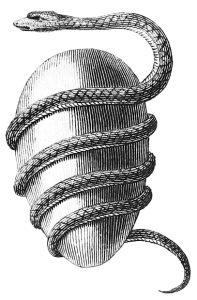
Orphic Egg, line drawing by Jacob Bryant (1774).
A depiction of the Orphic world-egg (the seed
of creation), within the coils of the serpent-formed
goddess of necessity, Ananke.
Here in Mark, the stakes are not so high! The repetition of the definite article (the word ho [ὁ]) indicates that the phrase “my beloved” is an attributive adjective, as it is in the parallel passage of the baptism of Jesus, back in 1.11. That in turn confirms that it is the fact of Jesus’ sonship that is the topic of both sentences; unlike in John, there does not appear to be a theological point hanging on this. I’m not entirely sure why this is what the Apostles needed to hear at this juncture; I have one theory, presented below after the textual notes.
i. no longer saw any one/saw no one no more: This double negative is not a typo: the phrase here, ouketi oudena [οὐκέτι οὐδένα], is a pair of negatives, because ancient Greek allows these, like modern Spanish. (Modern English is actually rather unusual, cross-linguistically, in pedantically counting out our negations; even Early Modern English used them fairly often.‡)
j. So they kept the matter to themselves/And they laid hold of the word: My translation here suggests an idiomatic expression; I’ve actually already departed a little from the literal in translating the verb as “lay hold of”—an absolutely literal rendering would be “they used strength upon the word” or something similar. I worded it as I did because I can’t tell whether the sense of the idiom is that they put Jesus’ instruction (of secrecy) into practice, or that they “seized upon the word” a little more literally, as a topic of their conversation (making the rest of the sentence basically an explanatory clause).
k. what the rising from the dead meant/what this “rising from the dead” is: It was tempting to translate this as “what it is, this ‘rising from the dead'”; I didn’t, basically because it sounded a little too Jersey to read with a straight face! Then again, maybe I should have. Jersey isn’t the only way to read it—it could (very appropriately) come off kinda New York Yiddish; and if God became man at all, I suppose he is related to New Jersey as much as to any other members of the human race.
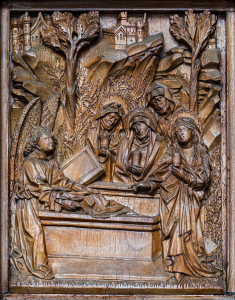
The Three Maries at the Tomb of Christ, by Simon Haider (1470).
Located at the west portal of Konstanz Minster, the proto-cathedral
of the Diocese of Constance (dissolved in 1821). Used under
a BY CC SA 4.0 license (source).
Why These Remarks “Out of the Cloud”?
“This is my Son, my beloved; listen to him.” Why is this the centerpiece of the Transfiguration?
We get a hint from Luke. All three Synoptic Gospels record the Transfiguration, but only Luke recounts what Jesus was talking about with Moses and Elijah: “his decease which he should accomplish at Jerusalem.” Interestingly, the King James here opted for a non-literal translation: the word “decease” represents exodos [ἔξοδος], like the name of the book, meaning “departure.” This could certainly be a euphemism for death; it could also refer to the whole process, death-resurrection-and-ascension; it could equally refer to the deliverance accomplished by either of these meanings (and it’s probably worth pointing out that none of these meanings are exclusive of the other two). In other words, they were discussing the same material which had just recently prompted Peter’s loyal, protective, sacrilegious contradiction of Jesus.
St. Peter’s reaction here (and who knows whether it even occurred to him to draw the parallel with the previous week) is more reined-in; given his usual manner, it almost sounds shy. His words do still convey a kind of reluctance, however, or at least a desire to linger—which, who wouldn’t react that way to this experience! And as Peter’s well-meaning defiance has been shut down (for now), the august voice that comes with the descent of the cloud is far less severe with him in its reply than Jesus was a week ago, though no less firm in stating whom the initiative lies with here: “This is my Son, my beloved; listen to him.”
Footnotes
*Many archæologists interpret dedications “to YHWH and his Shekinah” as evidence of Israelite polytheism, understanding Shekinah as the name of a goddess, YHWH’s consort, in the style of Baal and Asherah (Canaanite polytheism seems to have been a little like the Hindu tradition of Shaktism, requiring a consort-goddess for the worship of a god). This is further interpreted to be evidence that the Hebrew Bible is not a historically reliable account of the Kingdoms of Israel and Judah, let alone of the earlier professed history it contains. Now, the first part of this (interpreting Shekinah as the name of an Asherah-like goddess), I’m prepared to accept. What little evidence I’ve heard does sound like it would fit equally well with the idea that “Shekinah” was more properly the Shekinah: a personified abstraction of the divine presence, one that was understood at the time to be simply a personified abstraction, and venerated in a symbolic fashion, rather than seriously conceived of as a distinct deity and worshiped as such. But, this isn’t my area, and I really haven’t seen much evidence anyway. The second part, however—the deduction that the historical parts of the Hebrew Bible are unreliable—absolutely baffles me. Who, on earth, could read the Hebrew Bible and take away from it the idea that it claims the Israelites before the Exile actually, consistently practiced the monotheism God commanded them to? Who!? I demand to know!
**There’s a possible misunderstanding here. A person might put an attributive adjective in a sentence because the information is helpful, even essential; but this would not change the adjective from an attributive to a predicative. To take our example of eggs thrown at a clown, the speaker might add the detail because both they and the addressee were in a room filled mostly with uncooked eggs, making the word “cooked” an important identifying detail. But importance is not what the predicative/attributive distinction is really about. It’s about what role the adjective is playing grammatically—what the adjective is doing in the sentence, not what the speaker is doing with the sentence. (Grammar is way weirder than you would ever think it could be, y’all.)
†Socinianism (named for its originators, Lelio and Fausto Sozzini, Latinized as Lælius and Faustus Socinus) is one of the many heresies that erupted in the sixteenth century, ancestral to certain modern forms of Unitarianism. They are sometimes classified as Arians, though their Christology is actually even “lower” than that of Arius—Arius did believe that the divine Logos was the pre-existent agent through which all else was created and was supreme among creatures, whereas the Sozzinis did not believe in the pre-existence of the Logos and held that Jesus began to exist when he was conceived.
‡The transitions from Middle to Early Modern English, and from that to Modern English proper, are a bit messy. What’s relevant here is that double negatives were perfectly good Middle English (Chaucer used doubles, triples, and even quadruples), and remained in use all the way down to the early eighteenth century.



